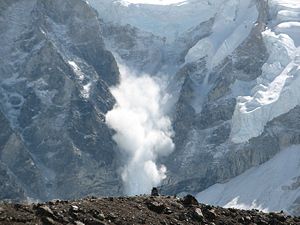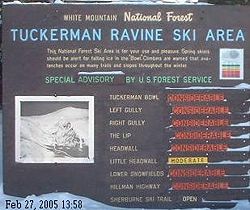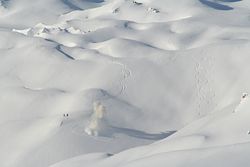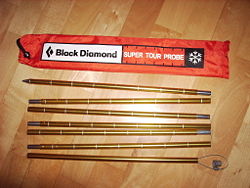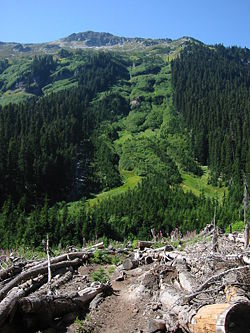Avalanche

An avalanche is a huge, rapid slide of snow, ice, rock, or soil down a mountainside. It is an example of a gravity current—that is, the material falls or slides under the force of gravity. When a mixture of materials falls, it is called a debris avalanche.
An avalanche is one of the major dangers faced in the mountains. A large avalanche can run for many miles, and can create massive destruction of the lower forest and anything else in its path. For example, in Montroc, France, in 1999, 300,000 cubic meters of snow slid on a 30-degree slope, achieving a speed of 100 kilometers per hour (60 miles per hour). It killed 12 people in their chalets under 100,000 tons of snow, five meters (15 feet) in depth. The mayor of Chamonix was convicted of second-degree murder for not evacuating the area, but received a suspended sentence.[1]
During World War I, over 60,000 soldiers died in the Alps as a result of avalanches, many of which were caused by artillery fire. It is highly doubtful that the avalanches were used as deliberate weapons; more likely, they were side effects of the shelling of enemy troops. Avalanche prediction is difficult even with detailed weather reports and core samples from the snowpack.
Causes
Avalanches occur when the load on the upper layers of snow, rock, or other material exceeds the bonding forces of the material, including support from anchors such as rocks and trees. Determining the critical load that would trigger an avalanche is a complex task involving evaluation of many factors. Some of them are:
Terrain
- Steepness — slopes under 25 degrees and over 60 degrees typically have a low avalanche risk because of the angle of repose for snow. Snow does not accumulate significantly on steep slopes and does not easily flow on flat slopes. Distribution of avalanches by slope has a sharp peak between 35 to 45 degrees. That peak hazard lies at around 38 degrees. Unfortunately, slopes with the most dangerous steepness are favored for skiing.
- Direction — The three primary variables that influence snowpack evolution are temperature, precipitation and wind. In medium latitudes of the Northern Hemisphere, more accidents occur on shady slopes with northern and northeastern aspects. Slopes in the lee of the wind accumulate more snow, presenting locally deep areas and windslabs. Cornices also accumulate on the downwind side of ridges, and can contribute to avalanche danger.
- Profile — convex slopes are statistically more dangerous than concave. The reasons lie partly in human behaviour, and the tensile strength of snow layers versus the compression strength.
- Surface — Full-depth avalanches are more common on slopes with smooth ground cover such as grass or rock slab. Vegetation cover is important for anchoring the snowpack; however in certain snowpacks boulders or buried vegetation may create weak areas within the snowpack.
Snow
The structure of the snowpack determines avalanche danger. Avalanches require a buried weak layer (or instability) and an overlying slab. Unfortunately relations between easily observable properties of snow layers (strength, grain size, grain type, temperature) and avalanche danger are complex and not yet fully understood. Additionally snow cover varies in space and so does stability of snow.
- New snow — New snow has not had time to bond with the layers below, especially if it is light and powdery.
- Snow depth — Snow that is above the layer of boulders and plants on the slope has none of these natural objects to help anchor it to the slope, and is therefore more dangerous. Naturally, this is just the type of snow needed for snow sports such as skiing.
- Snow crystal size — Generally speaking, the larger the crystal, the weaker it is.
- Snow compaction — Compacted snow is less likely to move than the light powdery layers.
Weather
Weather determines the evolution of snowpack. The most important factors are heating by solar radiation, radiational cooling, temperature gradients in snow, and snowfall amounts and type. Most avalanches happen during or soon after a storm.
- Temperature — If the temperature is high enough for gentle freeze-thaw cycles to take place, the melting and re-freezing of water in the snow strengthens the snowpack during the freeze cycle and weakens it in the thaw cycle. Temperatures rising significantly over the freezing point may cause the whole slope to avalanche, especially in spring. Persistent cold temperatures cause the snow to not gain stability and may contribute to formation of depth hoar, where there is a high temperature gradient within the snow. Thin layers of "faceted grains" may form above or below crusts when temperature gradients become strong through the crust.
- Wind — anything more than a gentle wind can contribute to rapid build up of snow on sheltered slopes (downwind), while the wind pressure can also stabilize other slopes. "Wind slab" is a particularly fragile brittle structure—heavily loaded, poorly bonded. Even on a clear day, wind can quickly shift snow-load to the snow pack. This can occur two ways, by top-loading, where wind deposits snow parallel to the fall-line, or through cross-loading, which occurs when the wind deposits snow perpendicular to the fall-line of a slope. When wind blows over the top of a mountain, the leeward, or downwind, side of the mountain experiences top-loading. When the wind blows over a ridge that leads up the mountain for example, the leeward side of the ridge experiences cross-loading. Cross-loaded wind-slabs are usually more difficult to spot and also tend to be less stable than top-loaded wind-slabs, and are therefore much more dangerous.
- Heavy snowfall — Heavy snowfall may cause instability, both through the additional weight, and because the snow has insufficient time to bond.
- Rain — In the short-term causes instability through additional load and possible lubrication of lower layers. Avalanche also occurs if the upper snow layer is moved. Rain reduces friction in the snowpack.
Avalanche avoidance
Due to the complexity of the subject, winter traveling in the backcountry (off-piste) is never 100 percent safe. Good avalanche safety is a continuous process, including route selection and examination of the snowpack, weather conditions, and human factors.
Several well-known good habits can also minimize the risk. If local authorities issue avalanche risk reports, they should be considered and all warnings heeded. Never follow in the tracks of others without your own evaluations; snow conditions are almost certain to have changed since they were made. Observe the terrain and note obvious avalanche paths where vegetation is missing or damaged, where there are few surface anchors, and below cornices or ice formations. Avoid traveling below others who might trigger an avalanche.
Prevention
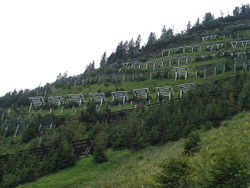
There are several ways to prevent avalanches and lessen their power and destruction. They are employed in areas where avalanches pose a significant threat to people, such as ski resorts and mountain towns, roads and railways. Explosives are used extensively to prevent avalanches, especially at ski resorts where other methods are often impractical. Explosive charges are used to trigger small avalanches before enough snow can build up to cause a large avalanche. Snow fences and light walls can be used to direct the placement of snow. Snow builds up around the fence, especially the side that faces the prevailing winds. Downwind of the fence, snow buildup is lessened. This is caused by the loss of snow at the fence that would have been deposited and the pickup of the snow that is already there by the wind, which was depleted of snow at the fence. When there is a sufficient density of trees, they can greatly reduce the strength of avalanches. They hold snow in place and when there is an avalanche, the impact of the snow against the trees slows it down. Trees can either be planted or they can be conserved, such as in the building of a ski resort, to reduce the strength of avalanches.
Artificial barriers can be very effective in reducing avalanche damage. There are several types. One kind of barrier uses a net strung between poles that are anchored by guy wires in addition to their foundations. These barriers are similar to those used for rockslides. Another type of barrier is a rigid fence like structure and may be constructed of steel, wood or pre-stressed concrete. They usually have gaps between the beams and are built perpendicular to the slope, with reinforcing beams on the downhill side. Rigid barriers are often considered unsightly, especially when many rows must be built. They are also expensive and vulnerable to damage from falling rocks in the warmer months.
Finally, there are barriers that stop or deflect avalanches with their weight and strength. These barriers are made out of concrete, rocks or earth. They are usually placed right above the structure, road or railway that they are trying to protect, although they can also be used to channel avalanches into other barriers. Occasionally, mounds of earth are placed in the avalanche's path to slow it down.
Traveling in Groups
- Traversing — Traversing is to be avoided to minimize cutting across the slope.
- Risk exposure — Minimize the number of people on the slope. Maintain separation. Ideally one person should pass over the slope into an avalanche protected area before the next one leaves protective cover. Route selection should also consider what dangers lie above and below the route, and the consequences of an unexpected avalanche (i.e., unlikely to occur, but deadly if it does). Stop or camp only in safe locations. Wear warm gear to delay hypothermia if buried. Plan escape routes.
- Group size — Do not travel alone. There will be no-one to witness your burial and start the rescue. The party should be large enough to perform a rescue, but additional people will increase the disturbance to the slope. Members should be aware of their duties to search.
- Leadership — If you find yourself in a potentially dangerous avalanche situation, you should seriously question the choice of route, why your safety is being put in jeopardy, and what alternatives might be safer than pressing on.
Human survival and avalanche rescue

Even small avalanches are a serious danger to life, even with properly trained and equipped companions who avoid the avalanche. Between 55 and 65 percent of victims buried in the open are killed, and only 80 percent of the victims remaining on the surface survive.[2]
Research carried out in Italy[3] based on 422 buried skiers indicates how the chances of survival drop:
- very rapidly from 92 percent within 15 minutes to only 30 percent after 35 minutes (victims die of suffocation)
- near zero after two hours (victims die of injuries or hypothermia)
Historically, the chances of survival were estimated at 85 percent within 15 minutes, 50 percent within 30 minutes, 20 percent within one hour. Consequently, it is vital that everyone surviving an avalanche is used in an immediate search and rescue operation, rather than waiting for help to arrive. Additional help can be called once it can be determined if anyone is seriously injured or still remains unaccountable after the immediate search (i.e., after at least 30 minutes of searching). Even in a well-equipped country such as France, it typically takes 45 minutes for a helicopter rescue team to arrive, by which time most of the victims are likely to have died.
In some cases avalanche victims are not located until spring thaw melts the snow, or even years later when objects emerge from a glacier.
Search and rescue equipment
Chances of a buried victim being found alive and rescued are increased when everyone in a group is carrying and using standard avalanche equipment, and have trained in how to use it. However, like a seat belt in a vehicle, using the right equipment does not justify exposing yourself to unnecessary risks with the hope that the equipment might save your life when it is needed.
Avalanche cords
Using an avalanche cord is the oldest form of equipment—mainly used before beacons became available. The principle is simple. An approximately 10-meter red cord (similar to parachute cord) is attached to the person in question's belt. While skiing, snowboarding, or walking the cord is dragged along behind the person. If the person gets buried in an avalanche, the light cord stays on top of the snow. Due to the color the cord is easily visible for rescue personnel. Typically the cord has iron markings every one meter that indicate the direction and length to the victim.
Beacons
Beacons—known as "beepers," peeps (pieps), ARVAs (Appareil de Recherche de Victimes en Avalanche, in French), LVS (Lawinen-Verschütteten-Suchgerät, Swiss German), avalanche transceivers, or various other trade names, are important for every member of the party. They emit a "beep" via 457 kilohertz radio signal in normal use, but may be switched to receive mode to locate a buried victim up to 80 meters away. Analog receivers provide audible beeps that rescuers interpret to estimate distance to a victim. To be effective, beacons require regular practice. Some older models of beepers operated on a different frequency (2.275 kHz) and a group leader should ensure these are no longer in use.
Recent digital models also attempt to give visual indications of direction and distance to victims and require less practice to be useful. There are also passive transponder devices that can be inserted into equipment, but they require specialized search equipment that might only be found near an organized sports area.
Mobile phones can seriously disrupt the ability of a beacon to receive a transmitting beacon's signal. Phones should be switched off when searching.
Probes
Portable (collapsible) probes can be extended to probe into the snow to locate the exact location of a victim at several yards/meters in depth. When multiple victims are buried, probes should be used to decide the order of rescue, with the shallowest being dug out first since they have the greatest chance of survival.
Probing can be a very time-consuming process if a thorough search is undertaken for a victim without a beacon. In the U.S., 86 percent of the 140 victims found (since 1950) by probing were already dead.[4] Survival/rescue more than two meters deep is relatively rare (about four percent). Probes should be used immediately after a visual search for surface clues, in coordination with the beacon search.
Shovels
When an avalanche stops, the deceleration normally compresses the snow to a hard mass. Shovels are essential for digging through the snow to the victim, as the deposit is too dense to dig with hands or skis.
A large scoop and sturdy handle are important. Shovels are also useful for digging snow pits as part of evaluating the snowpack for hidden hazards, such as weak layers supporting large loads.
Other devices
Other rescue devices are proposed, developed and used, such as avalanche balls, vests and airbags, based on statistics that most deaths are due to suffocation. There are also passive signaling devices that can be carried or inserted into sports equipment, but they require specialized search equipment which might only be found near an organized sports area.
When considering any of theses devices, one should consider that if the group does not recover the avalanche victim within 15 minutes, the chance of survival rapidly decreases. Reliance on technology to summon outside help is used with the knowledge that those responding will likely be performing a body recovery. Any group that wants to survive must be capable of self-rescue.
More backcountry adventurers are also carrying EPIRBs (Emergency Position-Indicating Radio Beacons) with GPS. This device can quickly notify search and rescue of an emergency and the general location (within 100 yards), but only if the person with the EPIRB has survived the avalanche and can activate the device manually. With modern mobile phone developments, an emergency GPS transmitter may also become more widely available (again, for use by a rescuer, because a victim may be unconscious or completely immobilized beneath dense snow).
Although it will be very inefficient, some rescue equipment can also be hastily improvised: ski poles can become short probes, skis or snowboards can be used as shovels.
A first aid kit and equipment will also be useful for assisting survivors who may have cuts, broken bones, or other injuries, in addition to hypothermia.
Witnesses as rescuers
Survival time is short if a victim is buried. There is no time to waste before starting a search, and many people have died because the surviving witnesses failed to do even the simplest search.
Witnesses to an avalanche that engulfs people are frequently limited to those in the party involved in the avalanche. Those not caught should try to note the locations where the avalanched person or people were seen. This is such an important priority it should be discussed before initially entering an avalanche area. Once the avalanche has stopped, and there is no danger of secondary slides, these points should be marked with objects for reference. Survivors should then be counted to see who may be lost. If the area is safe to enter, a visual search of the likely burial areas should begin (along a downslope trajectory from the marked points last seen). Some victims are buried partially or shallowly and can be located quickly by making a visual scan of the avalanche debris and pulling out any clothing or equipment found. It may be attached to someone buried.
Alert others if a radio is available, especially if help is nearby, but do not waste valuable resources by sending a searcher for help at this point. Switch transceivers to receive mode and check them. Select likely burial areas and search them, listening for beeps (or voices), expanding to other areas of the avalanche, always looking and listening for other clues (movement, equipment, body parts). Probe randomly in probable burial areas. Mark any points where signal was received or equipment found. Only after the first 15 minutes of searching should consideration be given to sending someone for help. Continue scanning and probing near marked clues and other likely burial areas. After 30-60 minutes, consider sending a searcher to get more help, as it is more likely than not that any remaining victims have not survived.
Line probes are arranged in most likely burial areas and marked as searched. Continue searching and probing the area until it is no longer feasible or reasonable to continue. Avoid contaminating the scent of the avalanche area with urine, food, spit, blood, etc, in case search dogs arrive.
The areas where buried victims are most likely to be found are: below the marked point last seen, along the line of flow of the avalanche, around trees and rocks or other obstacles, near the bottom runout of the debris, along edges of the avalanche track, and in low spots where the snow may collect (gullies, crevasses, creeks, ditches along roads, etc). Although less likely, other areas should not be ignored if initial searches are not fruitful.
Once a buried victim is found and his or her head is freed, perform first aid (airway, breathing, circulation/pulse, arterial bleeding, spinal injuries, fractures, shock, hypothermia, internal injuries, etc.), according to local law and custom.
Victims
Victims caught in an avalanche are advised to try to ski or board toward the side of the avalanche until they fall, then to jettison their equipment and attempt swimming motions. As the snow comes to rest an attempt should be made to preserve an air-space in front of the mouth, and try to thrust an arm, leg or object above the surface, assuming you are still conscious. If it is possible to move once the snow stops enlarge the air space, but minimize movement to maximize the oxygen supply. Warm breath may soon cause a mask of ice to glaze over the snow in your face, sealing it against further air.
European avalanche risk table
In Europe, the avalanche risk is widely rated on the following scale, which was adopted in April 1993 to replace the earlier non-standard national schemes. Descriptions were last updated in May 2003 to enhance uniformity. In France, most avalanche deaths occur at risk levels 3 and 4. In Switzerland most occur at levels 2 and 3. It is thought that this may be due to national differences of interpretation when assessing the risks.[5]
| Risk Level | Snow Stability | Avalanche Risk |
|---|---|---|
| 1 - Low | Snow is generally very stable. | Avalanches are unlikely except when heavy loads [2] are applied on a very few extreme steep slopes. Any spontaneous avalanches will be minor (sluffs). In general, safe conditions. |
| 2 - Limited | On some steep slopes the snow is only moderately stable [1]. Elsewhere it is very stable. | Avalanches may be triggered when heavy [2] loads are applied, especially on a few generally identified steep slopes. Large spontaneous avalanches are not expected. |
| 3 - Medium | On many steep slopes [1] the snow is only moderately or weakly stable. | Avalanches may be triggered on many slopes even if only light loads [2] are applied. On some slopes, medium or even fairly large spontaneous avalanches may occur. |
| 4 - High | On most steep slopes [1] the snow is not very stable. | Avalanches are likely to be triggered on many slopes even if only light loads [2] are applied. In some places, many medium or sometimes large spontaneous avalanches are likely. |
| 5 - Very High | The snow is generally unstable. | Even on gentle slopes, many large spontaneous avalanches are likely to occur. |
[1] Stability:
- Generally described in more detail in the avalanche bulletin (regarding the altitude, aspect, type of terrain, etc.).
[2] additional load:
- heavy: two or more skiers or boarders without spacing between them, a single hiker or climber, a grooming machine, avalanche blasting.
- light: a single skier or snowboarder smoothly linking turns and without falling, a group of skiers or snowboarders with a minimum ten-meter gap between each person, a single person on snowshoes.
Gradient:
- gentle slopes: with an incline below about 30 degrees.
- steep slopes: with an incline over 30 degrees.
- very steep slopes: with an incline over 35 degrees.
- extreme steep slopes: extreme in terms of the incline (over 40 degrees), the terrain profile, proximity of the ridge, smoothness of underlying ground.
European avalanche size table
Avalanche size:
| Size | Runout | Potential Damage | Physical Size |
|---|---|---|---|
| 1 - Sluff | Small snow slide that cannot bury a person, though there is a danger of falling. | Relatively harmless to people | length <50 meters volume <100 meters³ |
| 2 - Small | Stops within the slope. | Could bury, injure or kill a person. | length <100 meters volume <1,000 meters³ |
| 3 - Medium | Runs to the bottom of the slope. | Could bury and destroy a car, damage a truck, destroy small buildings or break trees. | length <1,000 meters volume <10,000 meters³ |
| 4 - Large | Runs over flat areas (significantly less than 30 degrees) of at least 50 meters in length, may reach the valley bottom. | Could bury and destroy large trucks and trains, large buildings and forested areas. | length >1,000 meters volume >10,000 meters³ |
North American Avalanche Danger Scale
In the United States and Canada, the following avalanche danger scale is used.
| Probability and trigger | Degree and distribution of danger | Recommended action in back country |
|---|---|---|
| Low (green) | Natural avalanches very unlikely. Human triggered avalanches unlikely. Generally stable snow. Isolated areas of instability. | Travel is generally safe. Normal caution advised. |
| Moderate (yellow) | Natural avalanches unlikely. Human triggered avalanches possible. Unstable slabs possible on steep terrain. | Use caution in steeper terrain |
| Considerable (orange) | Natural avalanches possible. Human triggered avalanches probable. Unstable slabs probable on steep terrain. | Be increasingly cautious in steeper terrain. |
| High (red) | Natural and human triggered avalanches likely. Unstable slabs likely on a variety of aspects and slope angles. | Travel in avalanche terrain is not recommended. Safest travel on windward ridges of lower angle slopes without steeper terrain above. |
| Extreme (red/black border) | Widespread natural or human triggered avalanches certain. Extremely unstable slabs certain on most aspects and slope angles. Large destructive avalanches possible. | Travel in avalanche terrain should be avoided and travel confined to low angle terrain well away from avalanche path run-outs. |
See also
- Landslide
- Mountaineering
- Skiing
Notes
- ↑ PisteHors.com: Montroc Avalanche. Retrieved August 2, 2007.
- ↑ David McClung and Peter Shaerer, The Avalanche Handbook (Seattle, WA: The Mountaineers Books, 1993, ISBN 0898863643), 177.
- ↑ Nature 368: 21.
- ↑ McKay Jenkins, “And None Came Back,” Outside (February 2000). Retrieved August 2, 2007.
- ↑ David George, “An Analysis of French Avalanche Accidents for 2005-2006.” Retrieved August 2, 2007.
ReferencesISBN links support NWE through referral fees
- McClung, David and Peter Shaerer. 1993. The Avalanche Handbook. Seattle, WA: The Mountaineers Books. ISBN 0898863643.
- Munter, Werner. 2002. Drei mal drei (3x3) Lawinen. Risikomanagement im Wintersport. Bergverlag Rother. ISBN 3763320601 (partial English translation included in PowderGuide: Managing Avalanche Risk, ISBN 0972482733)
- Tremper, Bruce. 2001. Staying Alive in Avalanche Terrain. Seattle, WA: The Mountaineers. ISBN 0898868343.
External links
All links retrieved August 23, 2023.
- American Avalanche Association
- CyberSpace Avalanche Center
- Center for Snow and Avalanche Studies
- sportscotland Avalanche Information Service
- Avalanche Defense Photographs
Credits
New World Encyclopedia writers and editors rewrote and completed the Wikipedia article in accordance with New World Encyclopedia standards. This article abides by terms of the Creative Commons CC-by-sa 3.0 License (CC-by-sa), which may be used and disseminated with proper attribution. Credit is due under the terms of this license that can reference both the New World Encyclopedia contributors and the selfless volunteer contributors of the Wikimedia Foundation. To cite this article click here for a list of acceptable citing formats.The history of earlier contributions by wikipedians is accessible to researchers here:
The history of this article since it was imported to New World Encyclopedia:
Note: Some restrictions may apply to use of individual images which are separately licensed.
